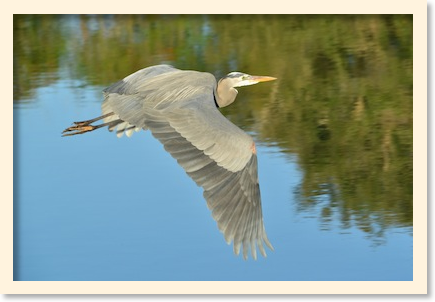The Great Blue Heron
Article and photo by D.W. Cloud

Most of its feathers are various shades of gray-blue; its head is white with a plume of feathers that form black stripes over the eyes; and the neck is light gray in the back and white in the front. The beak is yellow; the thighs are brown; the legs are greenish gray but become orange during breeding season; and the feet are yellow or orange. The long wings are two toned, with the feathers toward the front being light gray and the ones toward the back being darker blue-gray.
The Little Blue Heron is smaller and is grayish blue all over, including its neck, head, bill, and legs.
A white edition, sometimes called the great white heron though it is the same species as the great blue, is found only in southern Florida and some parts of the Caribbean and is found mainly along the coasts near salt water.
The name “great” comes from its size. It has a standing height of four feet and more, a wingspan of up to six feet, and weighs five to eight pounds.
When hunting, it stands still waiting for prey to come within range or stalks with very slow, deliberate steps, stunning or killing its prey with a thrust of its long neck. Special neck vertebrae allow the bird to curl its neck into an “S” shape and to uncurl it with lightning fast speed. The Great Blue Heron also eats mice, insects, and other small creatures, swallowing its prey whole.
Though large, the Great Blue Heron can cruise in flight at 20-30 miles per hour with its slow, deep wingbeats.
The Great Blue Heron hunts alone but nests in colonies of from five to more than 100 pairs. The male and female work together to build, incubate, protect, and feed the young. The male brings the nesting materials and the female builds the nest. Herons add more material to existing nests; therefore, an older heron nest can be determined by its large size.
The female sits on the eggs at night, while the male sits on them during the day. After the chicks hatch, the female watches the nest at night, while the male guards it during the day.
The Great Blue Heron were nearly hunted to extinction by the early 20th century because of the value of its beautiful plumage as a female hat accessory.
A group of herons is called a battery, a pose, a rookery, or a scattering.


